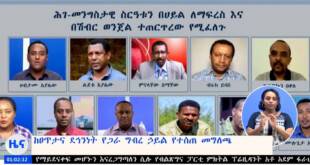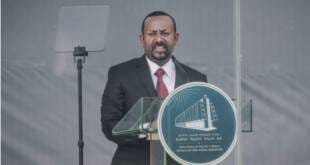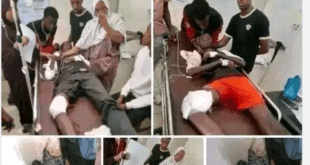The western media and its sponsors have gone to great lengths to present Ethiopia as a democratic nation whose economy is growing by “double digits”. The suffering Ethiopian people know better but have been muffled and prevented from expressing their aspirations and dreams by a minority mercenary regime. Over the last decade, Ethiopia has been hailed as the “fastest growing non-oil economies” in Africa, maintaining a double-digit annual economic growth rate. Ethiopia’s Gross Domestic Product may have grown (court is still out on that) but according to Simon Kuznets, “the welfare of a nation can scarcely be inferred from a measure of national income.” The measure was never intended as much more than a useful accounting device.
Reports on Ethiopia’s GDP say:
————————————————
* “…For the past 10 years, the country has registered an average 10.9 real GDP (Gross Domestic Product) growth rate and this trend has shown us that the country is in high economic growth trajectory…Our prediction for the current Ethiopian fiscal year is for the country to register an 11.3 economic growth…”-(Prime Minister Hailemariam Desalegn to Ethiopian Parliament, April 2014)
* “…Look at the year between 2013 and 2014, the GDP growth was about 10.6 per cent, double digits. Kenya did only 4.8 per cent, Rwanda which has been a very stellar performer did only 7.9 per cent…”[1]-(Elayne Wangalwa-CNBC Africa Nairobi)
* “…The ministry of finance and economic development on Wednesday announced that Ethiopia has registered an average of 10% economic growth during the past two years of the five-year Growth and Transformation Plan (GTP)…”-(Reuters, February 2013)[2]
* etc.
To a naïve reader, the statements present a very rosy picture of Ethiopia and hide the income inequalities, adjunct poverty and dismal standard of living that persist and the true state of the Ethiopian economy and its effects on the majority of the population.
Economic metrics can be misleading when viewed through the mirror of Gross Domestic Product (GDP), as progress may appear to be greater than what it really is. The GDP metric was developed in the United States during World War 2 as a tool to plan the enormous expansion in military procurement, while controlling inflation. GDP simply totals up the amount spent for all final goods and services produced within the country. GDP only deals in positive numbers, so doesn’t subtract out things like future obligations- it is easy to boost the economy by borrowing a lot of money. GDP measures only output, and makes no claims on the quality of that output, let alone on subjective concepts such as social progress or human happiness. GDP is the total value of all products and services bought and sold, a measure of money changing hands.
GDP is a misleading yardstick of true progress for many reasons, most of which fall under three major categories[3]:
1. “…The GDP makes no distinction between productive and destructive activities. While a realistic measure of progress would separate costs and benefits, the GDP places a positive value on all transactions and adds them to the total. Illness, crime, and natural disasters all cause the GDP to increase, as money is spent to treat the sick, jail prisoners, and repair the damage. In this way the GDP rises even as the quality of life declines…”
2. “….The GDP completely ignores all activities and services that have no price attached to them. Essential functions performed by the family, community, and volunteers, such as housework and child care, don’t count in the GDP. When these services have to be paid for because people no longer have time for them, the GDP goes up — putting a positive value on the erosion of the social fabric…”
3. GDP also has nothing to say about how income and wealth are distributed among the people.
There are many activities that play an important role in raising living standards but are not included in GDP. James K. Boyce, a Professor at University of Massachusetts says:
“…If ever there was a controversial icon from the statistics world, GDP is it. It measures income, but not equality, it measures growth, but not destruction, and it ignores values like social cohesion and the environment. GDP does not take environmental degradation, insecurity or inequality into account…”
The GDP values growth over the things that really matter to people, such as access to food, Ethiopia’s children eating from trashshelter, clean air and water, and a healthy and safe environment for all. GDP should not be considered a definitive measurement of human welfare, as the case of Ethiopia clearly illustrates.
So how are Ethiopians faring in this “growing economy”? How has the “double digit” growth in GDP translated in the lives of the Ethiopian people?
Let us begin with what the Feed the Future, the U.S. Government’s global hunger and food security initiative[4] says abut Ethiopia:
“…Ethiopia is among the poorest countries in the world, with a per capita GDP of $471… 38.7 percent of the population still lives below the poverty line, and life expectancy at birth is only 54.7 years….Under nutrition hampers both human and economic development. In Ethiopia, child under nutrition rates are among the highest in the world, and under nutrition contributes to 53 percent of infant and child deaths… Although the Government of Ethiopia has made significant improvements in decreasing rates of stunting and child anemia over the past ten years, maternal, infant, and young child feeding practices remain a concern… 44% of children under five are stunted…”
According to the United Nations, about 90 percent of the population suffers from numerous deprivations, ranging from inadequate health care to insufficient access to education. Inequality and the failure to make a dent in urban poverty are exacerbated in Ethiopia by high inflation, which hurts the poor disproportionately.
Ethiopia is characterized by a predominantly rural and impoverished population with limited access to safe water, housing, sanitation, food and health care. An Oxford University report said some 90 percent of Ethiopians still live in poverty, second only after Niger from 104 countries measured by the Oxford Multidimensional Poverty Index. The most recent data shows an estimated 71.1 percent of Ethiopia’s population lives in severe poverty.
Ethiopia faces famine where more than 13 million people need food aid. 6.2-million people will need emergency food aid while another 7.5-million chronically food-insecure Ethiopians receive assistance through the U.S.-funded program known as the Productive Safety Net.
In TPLF’s Ethiopia, one in eight children die before their fifth birthday and over 150,000 children live on the streets. Out of the five million orphaned children, about 800,000 were orphaned by HIV/AIDS. There are 1.5 million people in Ethiopia that are infected with HIV (sixth highest country in the world). A look at Ethiopia’s booming adoption economy finds the government of Ethiopia at its center-from ownership of the mushrooming orphanages and adoption agencies, the minority regime has no qualms about selling of Ethiopia’s children. Encourage Africa [3] says that Ethiopia counts one of the largest populations of orphans in the world. Of the 143 million orphans worldwide, more live in Ethiopia than any other country in the world.
Ethiopia’s Debt
———————-
Gains in income that come at the expense of future income, at the expense of future generations shouldn’t really be counted as gains. They should be counted as borrowing against the future rather than lifting Ethiopia’s level of income. In Ethiopia, the government enjoys a monopoly over domestic as well as international borrowing. Between 2000 and 2012, Ethiopia’s international public debt increased by 85% from US$5.339 billion to US$9.941 billion.
The World Bank says that “the external indebtedness of African countries is an obstacle to the ‘restoration’ of the conditions needed for growth.” The huge debt burden acts as a threat to the economic performance given the wide spread poverty and structural rigidities in these countries. According to Mundi, Ethiopia’s external debt stands at $11.99 billion (31 December 2013 est.), others have put it at about “12 to 14 billion USD”.
In 2005, the International Monetary Fund[5] announced that it would provide 100 percent debt relief on “all debt incurred by Ethiopia to the IMF before January 1, 2005” that remains outstanding. This also contributed to Ethiopia’s “double-digit GDP growth”. Despite that debt forgiveness, Ethiopia recorded a Government Debt to GDP of 27.40 percent of the country’s Gross Domestic Product in 2013. The total public debt, which includes domestic debt (from domestic sources), stands at 36 % of GDP. Government Debt to GDP in Ethiopia is reported by the National Bank of Ethiopia. For whatever reasons, the World Bank insists on providing Ethiopia with even more loans to squander at the expense of future generations.
Income Distribution
—————————-
As the joke goes, when Bill Gates walks into a bar, the average customer suddenly becomes a millionaire. High-end people raise the average, and that doesn’t mean that normal people in the room are any better off. When the regime in Ethiopia brags about “middle income status” for Ethiopia, it is referring to the few regime cadres and loyalists who have amassed wealth at the expense of the majority.
According to New World Wealth, a consultancy based in the UK and South Africa, in Ethiopia, a country where about one third of the people live on less than $1.25 a day, the “number of dollar millionaires” in rose from 1,300 in 2007 to 2,700 (108% increase). The increase in the number of millionaires in Ethiopia, we are told, is associated with the “economic growth” of the country. Andrew Amoils, a senior analyst at New World Wealth says that while there has been economic and wealth growth in Ethiopia, the growth is not necessarily shared by the majority of Ethiopians:
“…The millionaires are growing at a faster rate than the middle class, which doesn’t really exist in a lot of African countries, including Ethiopia…But whereas much of Africa’s boom has been driven by mineral resources, leading sectors for millionaires in Ethiopia include agriculture, manufacturing and transport…”
It does not need much query to know who the new millionaires are in today’s Ethiopia under the entrenched TPLF regime. Who is benefitting from the sale of Ethiopia’s precious resources, sale of Ethiopia’s most fertile lands, or the sale of Ethiopia’s children through adoption and other illicit conduct, or the debilitating corruption that prevails in all economic sectors in Ethiopia? Can we say there is economic growth in Ethiopia when hundreds and thousands are forced to leave their villages and homes, and when there are more than 100,000 young people roaming around the capital in search of food and twice that number who are destitute? Does the much touted “growth in GDP” indicate progress in Ethiopia, when the increasing income accrues to a very small section of the Ethiopian people?
Human Development Index (Source: United Nations Development Programme)[6]
The Human Development Index (HDI) offers a global perspective on the question of how well people are living. Devised by the United Nations in the 1990s, the HDI is a composite of three different indicators:
* Life expectancy at birth
* Education as measured by a combination of school enrollment and adult literacy
* Standard of living.
According to the regime and its handlers, Ethiopia has recorded some of the “highest growth rates in the world”-over 10 per cent in some years. However, Ethiopia’s Human Development Index (HDI) and its relative ranking have not moved appreciably during the past decade. Ethiopia ranks 173rd out of 186 countries in the latest UNDP Human Development Report. Ethiopia remains one of the poorest and least developed country in the world.
Social Progress Index
——————————–
Social Progress Index is the most inclusive and ambitious effort ever attempted to measure social progress comprehensively. It defines social progress according to three broad dimensions: Does a country have the capacity to satisfy the basic human needs of its people? Does a country have the institutions and conditions in place to allow its citizens and communities to improve their quality of life? And does a country offer an environment in which each citizen has the opportunity to reach his or her full potential?
No countries score in the top half for all 12 components of the index, which are nutrition and basic medical care; air, water and sanitation; shelter; personal safety; access to basic knowledge; access to information and communication; health and wellness; ecosystem sustainability; personal rights; access to higher education; personal freedom and choice; and equity and inclusion and higher or lower GDP is not a determinant of the scores.
According to the Social Progress Imperative[7], Ethiopia ranks at the bottom, 126th out of 133 countries, making it one of the lowest scores on the Social Progress Index.
Food Security
———————-
Despite a “fast-growing economy”, Ethiopia experiences high levels of both chronic and acute food insecurity, particularly among rural populations and smallholder farmers. According to USAID:
“…Approximately 44% percent of children under 5 years of age in Ethiopia are severely chronically malnourished, or stunted. This lack of nutrients results in irreversible cognitive and physical impairments…up to 3.2 million people are currently in need of emergency food assistance. Massive investments in the food aid program did not change the food security situation for people in Ethiopia. Despite decades of food aid, food insecurity remains a key challenge. The country has remained one of the most food-insecure in the world with nearly half of the population being undernourished…Ethiopia today is 123 out of 125 worst fed countries in the world…”
According to the World Food Programme report (WFP)[8]
* “…Ethiopia remains one of the world’s most food-insecure countries, where approximately one in three people live below the poverty line. The latest Humanitarian Requirement Document (HRD) released by the Government of Ethiopia and the humanitarian community, estimates that 3.2 million Ethiopians need relief food assistance in 2014 due to drought conditions in certain parts of the country…”
* “…In 2014, WFP Ethiopia is providing assistance to 6 million vulnerable people with food and special nutritional assistance, including refugees, school children, farmers, people living with HIV/AIDS, mothers and infants…”
* “…Under the Ethiopian government’s MERET programme, WFP aims to provide food assistance in 2014 to nearly 650,000 people participating in environmentally friendly public work projects such as sustainable land and water management.”
* “…WFP also plans to offer similar assistance this year to 1.2 million Ethiopians involved in public works projects like building roads and schools as part of the next phase of the government’s Productive Safety Net Programme (PSNP)…”
* “…WFP also offers special nutritional supplements to nearly 2 million most vulnerable Ethiopians – including pregnant women, nursing mothers, children under 5 and those living with HIV/AIDS…”
The number of Ethiopians in need of relief food assistance until the end of 2014 was estimated at 3.2 million, about 18.5 percent more than in the first half of the year. Ethiopia is WFP’s largest country of operations.
Access to clean water
——————————–
Access to water supply and sanitation in Ethiopia is amongst the lowest in Sub-Saharan dlp4_061071806.psAfrica and the entire world. Ethiopia boasts a population of about 83 million people and which only 38 percent have access to safe drinking water sources and only 12 percent of the population use improved sanitation facilities. Over half of Ethiopia’s population lacks access to drinking water, in spite of the large number of water resources available in the country, particularly in the subsoil and hundreds fall ill and die daily as a result of drinking contaminated water.
Accordingly to the 2015 assessment report by the UNICEF/WHO Global Joint Monitoring Programme for Water and Sanitation:
“… the total population reached with safe water between 1990 and 2015 is 48 million. There are still 42 million Ethiopians without access to safe water. Of the 42 million Ethiopians who are not using improved water supplies, an estimated 33 million people are residing in rural areas and peri urban communities and 9 million are living within towns and cities…”
The growth in Ethiopia’s GDP is not translating to access to water for more than half of its population-water is life- Water being one of the most essential elements to health, without it, it does not matter how big the GDP growth in Ethiopia is.
Health
———–
As Robert Kennedy once put it, GDP measures everything “except that which makes life worthwhile.” Ethiopia’s “double digit growth” in GDP says nothing about the health of the Ethiopian people. The World Health Organization[9] says:
* “….The burden of disease measured in terms of premature death is estimated at 350 disability adjusted life years lost per 1000 population, which is the highest in sub-Saharan Africa…The disease burden, responsible for 74% of deaths and 81% of disability adjusted life years lost per year, is dominated by malaria, prenatal and maternal death, acute respiratory infection, nutrition deficiency, diarrhea and HIV/AIDS…”
* “…In addition to the widespread poverty and low income level of the population, a low literacy rate (mainly among women) and lack of access to health care have contributed to ill health in the country…”
* “…Ethiopia has one of the world’s highest maternal mortality ratios, with an average 675 maternal deaths per 100 000 live births…”
* “…Nearly three quarters of Ethiopia is considered to be malaria prone…”
* “…Ethiopia ranks third in Africa and eight out of the 22 highest tuberculosis (TB) burdened countries in the world. The prevalence of all forms of TB is estimated at 527 per 100 000 population, leading to a 64 per 100 000 population mortality rate annually…”
The HIV/AIDS pandemic is driving poor people even deeper into poverty, depriving families of the young adults who are their most productive members. It is estimated that about 6 per cent of Ethiopia’s adult population is HIV-positive. Together, the HIV/AIDS pandemic and malaria seriously affect the health of large numbers of Ethiopians, many of them in rural areas. Diarrhea is the leading cause of Under-5 mortality in Ethiopia, causing 23% of all under-5 deaths (73,341 children per year). Around 44% of under-5 children in Ethiopia are stunted
The mainstream media and their sponsors ought to pay heed to the basic human needs of the Ethiopian people who are suffering under the clutches of an entrenched minority regime suffering from an incurable case of inferiority complex and crab mentality. Their children are paying the price for the regime’s mercenary adventures and military forays and wars of aggression and occupation. The poor people of Ethiopia are paying for the regime’s excesses and bearing the brunt of its repression.
When GDP is measured, it may be higher in the aid dependent Ethiopia ruled by the mercenary minority regime, and the “Darling of the West”, than in self-reliant Eritrea, but when life expectancy, food security, access to potable water, education, health, peace and security, etc. are measured, Eritrea’s social justice path is far more desirable, and more importantly sustainable. Touting Ethiopia’s growth in GDP is no longer something to cheer about, and it is past time to establish a new way to measure Ethiopia’s progress and stop insulting the intelligence of the Ethiopian people.
Instead of proving diplomatic, political, military shield and support to an entrenched regime that has been abusing the human rights of the Ethiopian people, stripping them of their dignity and pride and painting a rosy picture of an economy in which 60% of the regime’s national budget is supported by donors, it behooves Addis based journalists and diplomats to stop shoving the truth under the rug and call a spade a spade…you owe it to the people of Ethiopia on whose backs you have enriched yourselves.
Ethiopian-land-giveawaySo, to paraphrase Robert Kennedy, the Gross National Product does not allow for the health of Ethiopia’s children, the quality of their education, or the joy of their play. It measures everything, in short, except that which makes life worthwhile for the people of Ethiopia and future generations who are at risk .
[1] http://www.cnbcafrica.com/177111.aspx Accessed 05/31/2015 [2] http://www.sudantribune.com/spip.php?article45425 Accessed 05/21/2015 [3] http://www.globalexchange.org/resources/econ101/gdp Accessed 05/31/2015 [4] http://www.feedthefuture.gov/…/ftf_factsheet_ethiopia_jan20…Accessed 05/31/2015 [5] https://www.imf.org/external/np/sec/pr/2005/pr05292.htm Accessed 05/21/2015 [6] http://hdr.undp.org/…/national-human-development-report-201…Accessed 06/02/2015 [7] http://www.socialprogressimperative.org/data/spi Accessed 06/11/2015 [8] https://www.wfp.org/countries/ethiopia/overview Accessed 05/31/2015 [9] http://www.aho.afro.who.int/…/Ethiopia:Analytical_summary_-…Accessed 06/02/2015Source Link : http://stesfamariam.com/




